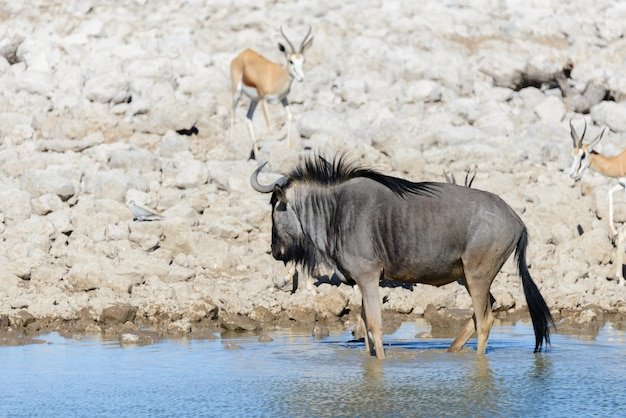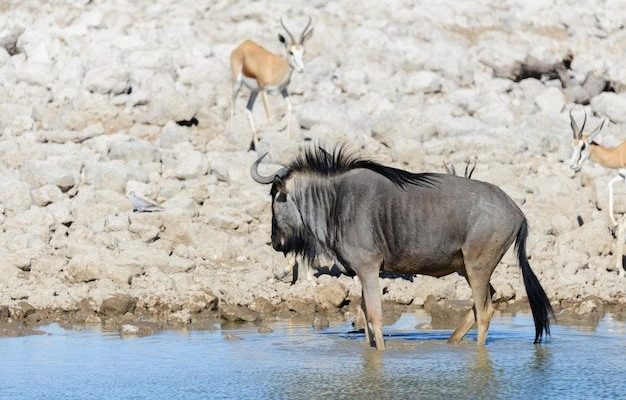
Here’s the thing: encountering wildlife can be a thrilling experience, but knowing how to handle it is key. Think of it like navigating a big city where you don’t know the roads; you need some guidance to stay safe. In this article, we’ll walk through what to do if you find yourself face-to-face with a gnu—what to expect, how to act, and some fun facts about these unique animals.
Understanding Gnus: The Basics
Before jumping into what to do when you see a gnu, it’s useful to understand a bit about them. Gnus are large, antelope-like mammals native to Africa. They are known for their distinctive appearance, with a robust body, a large head, and long, curved horns. You might be wondering why these animals matter. Well, they play a vital role in their ecosystem by helping to maintain the balance of grasses and providing food for predators.
There are two main species of gnu: the black wildebeest and the blue wildebeest. The blue wildebeest is perhaps the more well-known of the two, often seen in large herds during the Great Migration in East Africa. It’s a sight to behold, but keep in mind that their herding behavior is a survival tactic—safety in numbers! When you come across a gnu, you’re actually witnessing a piece of this fascinating natural world.
Stay Calm and Assess the Situation
First things first—if you see a gnu, take a deep breath and stay calm. Animals can sense your emotions, and panicking won’t help either you or the animal. Look at the situation carefully. Is the gnu alone, or is it part of a larger herd? Understanding whether it’s a solitary gnu or part of a group can change how you approach the encounter.
If the gnu seems relaxed, it’s likely going about its business, grazing or resting. However, if it’s agitated—snorting, pawing the ground, or standing with its head raised—it’s best to back away slowly. Remember, a gnu is a wild animal, and they can become defensive, especially if they feel threatened.
Keep Your Distance: The 50-Foot Rule
When you encounter a gnu, maintaining a safe distance is crucial. A good guideline is the 50-foot rule. This means keeping at least 50 feet away from the animal. This distance helps ensure that the gnu doesn’t feel cornered and reduces the risk of startling it.
Why 50 feet, you ask? Well, it’s far enough that you can still observe the gnu without intruding on its space. Plus, it’s a safe margin that gives you time to react if the gnu decides to charge—although this is rare, it’s always better to be prepared. If you find yourself closer than that, slowly back away.
Don’t Approach or Feed the Gnu
You might be tempted to get a closer look or even try to feed the gnu. After all, who wouldn’t want a selfie with such an iconic animal? But here’s the thing: approaching or attempting to feed a gnu can lead to serious trouble—for both you and the animal.
Wild animals should not be fed. It disrupts their natural foraging habits and can make them reliant on humans for food, which isn’t good for their survival. Plus, if a gnu feels threatened while you’re trying to feed it, it may react aggressively. It’s best to enjoy their beauty from a distance, taking mental snapshots instead of physical ones.
Observe Behavior for Signs of Agitation
Understanding a gnu’s body language can help you gauge how to react. If the gnu begins to stomp its hooves, snort, or lower its head, those are clear signs of agitation. Gnus can be surprisingly quick, so recognizing these signals early gives you a heads-up to back off.
Conversely, if the gnu is munching on grass or lying down, it’s less likely to be a threat. Animals that are relaxed usually don’t pose much danger. However, it’s always wise to keep your distance, as you never know how an animal might react if startled.
When to Seek Help: Calling Wildlife Authorities
If you find that the gnu appears injured or is in a location where it poses a risk to itself or others, don’t hesitate to contact local wildlife authorities. They have the training and knowledge to handle such situations safely.
Make sure to provide as much information as possible when you call—where you spotted the gnu, any signs of injury, and the behavior you observed. This helps them determine the best course of action. Remember, it’s better to be safe than sorry, especially with wild animals.
Enjoying the Experience: Take a Moment to Appreciate
Finally, if you find yourself lucky enough to encounter a gnu, take a moment to just appreciate the experience. Watching wildlife can be awe-inspiring and is a reminder of the beauty of nature. You can learn a lot from observing how these animals interact with their environment and each other. So, while you’re keeping your distance, use the opportunity to soak in the surroundings and maybe even jot down some notes or sketches.
Remember, wild encounters can be unpredictable, but they also carry a unique charm. You’ll build memories that last a lifetime while respecting the natural world.
In conclusion, knowing what to do if you encounter a gnu in the wild can help make the experience safer and more enjoyable. Remember to stay calm, keep your distance, and observe from afar. If you find yourself needing help, don’t hesitate to call in the experts. By respecting these incredible animals, you’re contributing to the preservation of wildlife and ensuring future generations can experience the wonder of nature. Happy adventuring!

